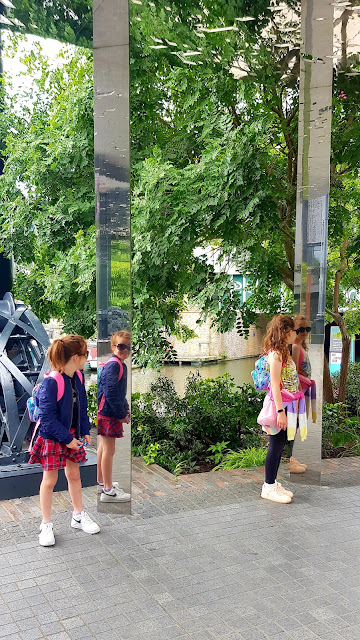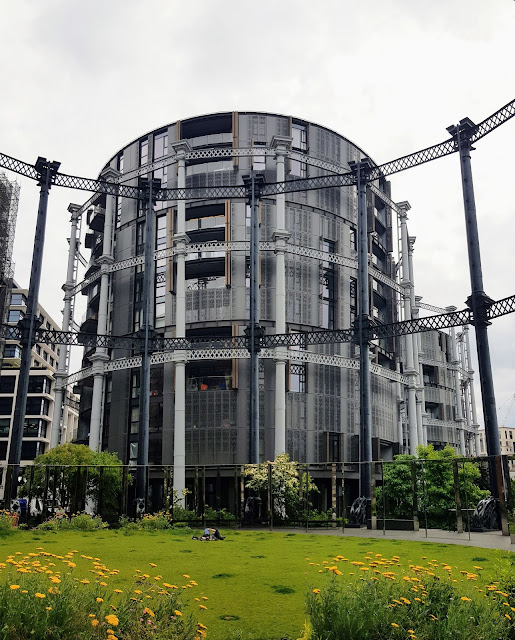 |
| The guide frame for gasholder No. 8. |
Some of the most striking buildings that have been part of the King's Cross skyline, for over 150 years, are the gasholders. These giant cast-iron buildings were in use until the late 20th century, but soon became redundant and, along with the rest of the area, fell into disrepair.
I have seen these gasholders from trains, but never up close, so was looking forward to paying them a visit.
Walking along the Regent's Canal, from Camden, these iconic buildings now stand just east of the main rail line, at St Pancras Basin.
One of them stands completely empty with just its wrought iron columns and girders surrounding the small park at its centre.
 |
| Erin & Keilyn checking out their reflections in Gasholder No. 8. |
It is a wonderful place to sit and relax, with mirrored surfaces reflecting the ambient light, which is supplemented in the evening with extra lighting.
Three other gasholders have been converted into apartments with roof gardens, offering amazing views across the city for those lucky enough to live here.
Fortunately for King's Cross, but not for Waterloo, the decision to move the Channel Tunnel Rail Link from Waterloo to St Pancras was what caused the regeneration of the area.
With grassy areas and the canal, this is a great place to stroll on a warm day, whether as a stop-off on your way to Coal Drops Yard and further east, or heading west to Camden and onto Little Venice.
Brief History
Gasholder No. 8.
 |
| The guide frame of Gasholder No. 8. |
This was the largest of the King's Cross gasholders and was constructed in 1850 and expanded in 1883. When used to capacity it could hold 1.1 million cubic feet of gas.
Its frame consists of 16 hollow cylindrical cast iron columns in two tiers two, levels of wrought iron riveted lattice girders. Standing at 25 m (82 ft) it has an internal diameter of more than 35 m (115 ft).
It was decommissioned in 2000 and was dismantled in 2011, when it was taken to Yorkshire to be refurbished. It was brought back and reinstated in 2013.
 |
| Looking at Gasholders Nos. 10, 11 & 12. |
At its centre is Gasholder Park and small events space and, with paths leading to the canal, it offers a great place from which to relax and look out over Camley Street Natural Park.
Gasholders Nos. 10, 11 & 12.
 |
| The Siamese Triplet. |
These three gasholders, known as the Siamese Triplet, as they are joined by a central spine, were built to hold gas for the largest gasworks in London, Pancras Gasworks.
Constructed between 1860-1867 and enlarged between 1879-1880, when new interconnected guide frames and telescopic lifts, they would continue to store gas until the late 20th century.
 |
| Every part has been refurbished and reinstalled. |
The Imperial Gas, Light and Coke Company manufactured gas, using coal, until the late 20th century, when the gasworks was decommissioned. Then, like Gasholder No. 8, they were removed to Yorkshire, where a specialist firm refurbished them, before returning them to their current position on the banks of the Regent's Canal.
 |
| Camley Street Natural Park, across the canal from the Gasholders. |
These iconic Grade II listed structures are now home to the Gasholder apartments, which have roof gardens, for the lucky inhabitants, offering amazing views of this part of the city.
Love it around King's Cross. The regeneration is fabulous with bold use of the gas holders. A great place to visit.
ReplyDelete